![]()
![]()
![]()
Use LEFT and RIGHT arrow keys to navigate between flashcards;
Use UP and DOWN arrow keys to flip the card;
H to show hint;
A reads text to speech;
25 Cards in this Set
- Front
- Back
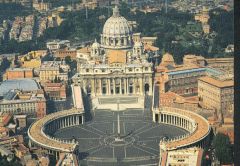
|
ID: Saint Peter's, Vatican City, Rome, Italy. Piazza designed by Gianlorenzo Bernini, 1656-1667.
Stylistic pd./culture: Baroque- Italy Subject Ico.: Incorporates a fountain constructed by Maderno and an Egyptian obelisk. Colonnades- extend a dramatic gesture of embrace to those entering the piazza. Symbolic of the welcome given by the Roman Catholic Church to its members during the Counter Reformation. Welcoming arms of Saint Peters Style/Techn.: Geometric, dome, dramatic, colonnade-framed, tuscan columns Sign./Func.Purp.: commissioned to be built as a monumental colonnade-framed piazza in front of Maderno's facade. Colonnades- visually serve to counteract the natural perspective and to bring the facade closer to the viewer. |
|
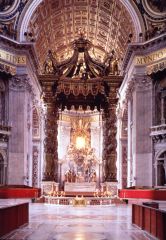
|
ID: Gianlorenzo Bernini, Baldacchino, Saint Peter's, Vatican City, Rome, Italy, 1624-1633
Stylistic pd./culture: Baroque- Italy Subject Ico.: Marks the high altar and the tomb of Saint Peter. The columns create a visual frame for the sculpture representing Saint Peter's throne Decorative elements represent the power of the Catholic church Angels stand guard at the upper corners of the canopy The orb and cross symbolize the Church's triumph Style/Techn.: canopy-like structure, dramatic, spiral columns, lost-wax process, chasing, bronze, brass, wood Sign./Func./Purp.: placed under Giacomo della Porta's dome. The four spiral columns are Baroque versions of ancient baldacchino columns over the same spot in Old Saint Peter's (invokes the past to reinforce the primacy of the 17th century Roman Catholic Church. |
|
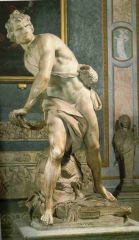
|
ID: Gianlorenzo Bernini, David, 1623. Marble. 5'7" high/ Galleria Borghese, Rome.
Stylistic Pd./Culture: Baroqie-Italy Subject Ico.: Represents the combat as David begins to slay Goliath Style/Technique: VERY dramatic, pivoting motion, expression of intense concentration, continuum Sign./Func./Purp.: Catches the split-second of maximum action |
|
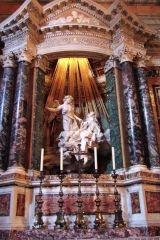
|
ID: Gianlorenzo Bernini, Ecstasy of St. Theresa, Cornaro chapel, Santa Maria della Vittoria, Rome, Italy, 1645-1652. Marble, height of group 11'6".
Stylistic pd./culture:Baroque- Italy Subject Ico.: Saint Teresa of Avila is a nun of the Carmelite order and is also one of the great mystical saints of the Spanish Counter-Reformation. Includes members of the Cardinal Federico Cornaro family Teresa depicted in ecstasy = spiritual and physical passion Light from hidden window= radiance of Heaven Style/Technique: Use of light, polychrome marble, VERY dramatic, expression, many different textures, harmony, romanticized Sign./Func./Purp.: serves as am intense, emotional experience of devotion for worshipers |
|
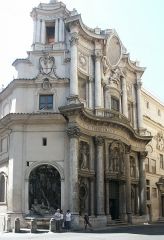
|
ID: Francesco Borromini, facade of San Carlo alle Quattro Fontane, Rome, Italy, 1638-1641
Stylistic pd./culture: Baroque- Italy Subject Ico.: Set in motion Interior + exterior space = a fluid transition Style/Technique: undulating motion. three-dimensional, innovative style, centrally-planned church, Greek cross + oval, projecting columns, oval dome Sign./Func./Purp: Borromini didn't believe that a church should have a flat frontispiece, and so instead, he created a dynamic counterpoint of convex elements and concave. |
|
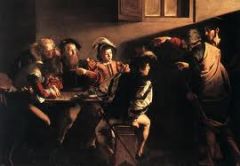
|
ID: Caravaggio, Calling of Saint Matthew, ca. 1597-1601. Oil on canvas, 11'1" X 11'5". Contarelli chapel, San Luigi dei Francesi, Rome.
Stylistic pd./culture: Italian Baroque painting Subject Ico.: Christ summons Levi (Roman tax collector) to a higher calling. Levi, astonished, points to himself in disbelief Style/Technique: chiaroscuro, expression, mysterious shadow Sign./Func./Purp.: Created for the Contarelli chapel in San Luigi dei Frencesi in Rome, honoring Saint Matthew. |
|
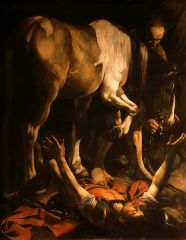
|
ID: Caravaggio, Conversion of Saint Paul, ca. 1601. Oil on canvas, 7'6" X 5'9". Cerasi chapel, Santa Maria del Popolo, Rome.
Stylistic pd./culture: Italian Baroque Subjet Ico.: Represents the saint-to-be bat the moment of his conversion Designed for its specific location on the chapel wall Resembles a stage production The light shining down on Paul = the light of divine revelation converting him to Christianity The viewer becomes a witness Style/Technique: eloquence, humanity, chiaroscuro, dramatic, tenebrism,realistic Sign./Func./Purp.: Painted for the Cerasi chapel in Santa Maria del Popolo |
|
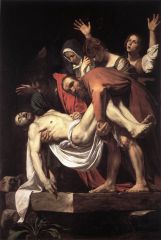
|
ID: Caravaggio, Entombment, ca. 1603
Stylistic pd./Culture: Italian Baroque Subject Ico.: Style/Technique: perspective, chiaroscuro, acrion-dramatic Sign./Func./Purp.: |
|

|
ID: Fra Andrea Pozzo, Glorification of Saint Ignatius, ceiling fresco in the nave of Sant'Ignazio, Rome, Italy, 1691-1694.
Stylistic pd./culture: Italian Baroque Subject Ico.: Heaven is opening up above the conregation Christ receives Saint Ignatius Style/Technique: perspective, illusion, dramatic, theatrical Sign./Func./Purp.: Vast ceiling fresco for the church of Sant'Ignazio in Rome |
|
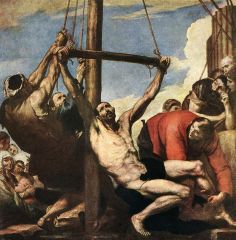
|
ID: Jose de Ribera, Martyrdom of Saint Philip, ca. 1639. Oil on canvas, 7'8" X 7'8". Museo del Prado, Madrid.
Stylistic pd./culture: Baroque in Spain Subject Ico.: Represents Philip's executioners hoisting him up into position after tying him to a cross (symbolic of the instrument of Christ's martyrdom) Style/Technique: dramatic, naturalism, expression Sign./Func./Purp.: Reflects on Spanish taste for stories and the harsh times of the Counter-Reformation, showcasing courage and devotion |
|
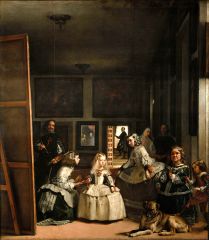
|
ID: Diego Velazquez, Las Meninas (The Maids of Honor), 1656. Oil on canvas, 10'5" X 9'. Museo del Prado, Madrid.
Stylistic pd./culture: Baroque in Spain Subject Ico.: The painter represents himself standing before a large canvas. The young Princess Margarita appears with her two maids, her favorite dwarfs, and a dog. A woman and male escort also appear in the scene What the painter is painting still remains a mystery Style/Technique: realistic, reflection, incorporates the viewer's space, form, tonal gradation Sign./Func./Purp.: Velazquez created this work both to elevate both the profession of the painting in the eyes of Philip IV and himself |
|

|
ID: Peter Paul Rubens, Elevation of the Cross, from Saint Walburga, Antwerp, 1610. Oil on wood, central panel 15/ 1 7/8" X 11' 1 1/2", each wing 15' 1 7/8" X 4'11". Antwerp Cathedral, Antwerp.
Stylistic pd./culture: Baroque in Flanders Subject Ico.: Christ is on the cross Episode from the passion cycle Style/Technique: Tenebrism, reflection, expression, dramatic, foreshortened anatomy Sign./Func./Purp.: Painted for the church of Saint Walburga in Antwerp. |
|

|
ID: Peter Paul Rubens, Arrival of Marie de' Medici at Marseilles, 1622-1625. Oil on Canvas, 12' 11 1/2" X 9'7". Musee du Louvre, Paris.
Stylistic pd./culture: Baroque in Flanders Subject Ico.: The sea and sky rejoice at the queen, Marie's safe arrival The Nereids and Neptune salute her as the winged and trumpeting Fame swoops overhead Style/Technique: natural, Sign./Func./Purp.: Glorifies Marie de' Medici's career |
|
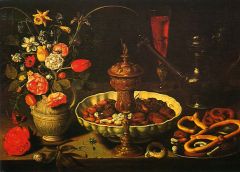
|
ID: Clara Peeters, Still Life with Flowers, Goblet, Dried Fruit, and Pretzels, 1611. Oil on panel, 1' 7 3/4" X 2' 1 1'4". Museo del Prado, Madrid.
Stylistic pd./culture: Baroque in Flanders Subject Ico.: Depicts a breakfast piece, revealing Peeter's virtuosity in depicting a variety of objects. Style/Technique: realistic, three-dimensional, dark background Sign./Func./Purp.: One of a series of four paintings, each depicting a typical meal of the early 17th-century |
|
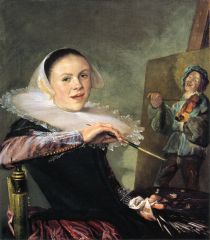
|
ID: Judith Leyster, Self-Portrait, c.1633, oil on canvas, National Gallery, Washington
Stylistic pd./culture: Baroque in Dutch Republic Subject Ico.: The artist, Judith is depicted smiling at us as she turns around to chat while engaged in her work Invites the viewer to evaluate her skill Style/Technique: realistic, impasto, relaxed pose Sign./Func./Purp.: Serves as a self-portrait of Judith; she presents herself as an artist who specializes in genre scenes an as a member of a well-to-do-family |
|

|
ID: Frans Hals, The Women Regents of the Old Men's Home at Haarlem, 1664. Oil on canvas, 5'7" X 8'2". Frans Halsmuseum, Haarlem.
Stylistic pd./Culture: Baroque in Dutch Republic Subject Ico.: The Haarlem regents quietly sit in a manner becoming of devout Calvinists. Style/Technique: monochromatic, expression, individualism Sign./Func./Purp.: Group portrait of Calvinist women engaged in charitable work |
|
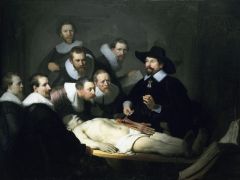
|
ID: Rembrandt Van Rijn, Anatomy Lesson of Dr. Tulp, 1632. Oil on canvas, 5'3 3/4" X 7' 1 1/4". Mauritshuis, The Hague.
Stylistic pd./culture: Baroque in Dutch Republic Subject Ico.: Portrays the members of the surgeons' guild Dr. Tulp is in the act of dissecting Style/Technique: individualism, expression, triangular composition of bodies Sign./Func./Purp.: Commissioned by the members of the surgeons' guild |
|
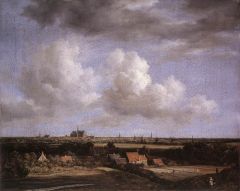
|
ID: Jacob Van Ruisdael, View of Haarlem from the Dunes at Overveen, ca. 1670. Oil on canvas, 1'10" X 2'1". Mauritshuis, The Hague.
Stylistic pd./culture: Baroque in Dutch Republic Subject Ico.: Depicts the Saint Bravo church and windmills The figures in the foreground stretching linen to be bleached serves as reflection of the pride Dutch painters took in recording their homeland and the activities that take place there Style/Technique: foreshortening, realistic, landscape Sign./Func./Purp.: serves as an overarching view of a major Dutch city. |
|
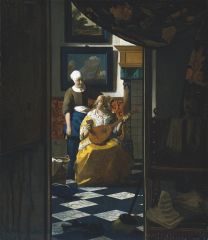
|
ID: Vermeer, The Letter, 1666.
Stylistic pd/culture: Baroque in Dutch Republic Subcject Ico.: The viewer is outside looking in through the drawn curtain Style/Technique: tenebrism, illusion, realistic Sign./Func./Purp.:work described by Vermeer's mom as the "Art of Painting" |
|
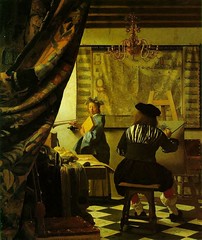
|
ID: Jan Vemeer, Allegory of the Arch of Painting, 1670-1675. Oil on canvas. 4'4" X 3'8". Kunsthistorisches Museum, Vienna.
Stylstic pd./culture: Baroque in Dutch Republic Subject Ico.: The artist appears in the painting, dressed in "historical" clothing, backing the audience, as he works hard, painting the model standing before him Style/Technique: realistic, viewer's perspective Sign./Func./Purp.: work described by Vermeer's mom as the "Art of Painting" |
|
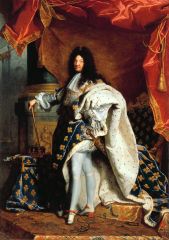
|
ID: Hyacinthe Rigaud, Louis XIV, 1701. Oil on canvas. 9'2" X 6'3". Musee du Louvre, Paris.
Stylistic pd./culture: Baroque in France Subject Ico.: depiction of Louis XIV as he gazes at the audience Robe hangs loosely from his left shoulder which suggests an air of haughtiness The king is shown exposing his legs - he was a ballet dancer in his youth Style/Technique: foreshortening, naturalistic Sign./Func./Purp.: serves as the image of an absolute monarch |
|

|
ID: Nicolas Poussin, Et in Arcadia Ego, ca. 1655. Oil on canvas, 2'10" X 4'. Musee de Louvre, Paris.
Stylistic pd./culture: Baroque in France Subject Ico.: Depicts three shepherds living in Arcadia, studying an inscription on a tomb as a female quietly places her hand on the shoulder of one of the shepherds, possibly symbolic of the spirit of death, reminding them that death occurs even in Arcadia. Style/Technique: Asymmetrical, natural, Greco-Roman like pose (female figure), reserved expression Sign./Func./Purp.: Arcadia was believed to be a spot of paradisaical bliss. |
|
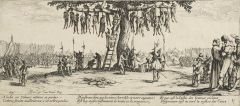
|
ID: Jacques Callot, Hanging Tree, from the Miseries of War series, 1629-1633. Etching, 3 3/4" X 7 1/4"
Stylistic pd./culture: Baroque in France Subject Ico.: Depiction of a mass execution of thieves Takes place in the presence of a disciplined army Monk climbs ladder and holds a crucifix up to a man while the executioner adjusts the noose around the man's neck Hanged men sway from branches Under the tree, men roll dice on a drum-head hoping to win the belongings of the executed Sign./Func./Purp.: Among the first realistic pictorial records of the human disaster of military conflict. |
|
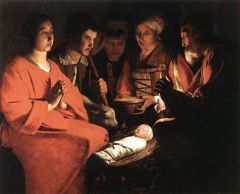
|
ID: Georges De La Tour, Adoration of the Shepherds, 1645-1650. Oil on canvas, 3'6" X 4'6".
Stylistic pd./culture: Baroque in France Subject Ico.: A group of hmble men and women gather in prayerful vigil around baby Jesus. Some believe it portrays a pagan scene. Style/Technique: natural, chiaroscuro, narration, spotlight. motion, emotive gesture Sign./Func./Purp.: serves as a candlelit nighttime scene and could be a genre piece instead of a biblical narrative |
|

|
ID: Louis Le Nain, Family of Country People, ca. 1640. Oil on canvas 3'8" X 5'2".
Stylistic pd./culture: Baroque in France Subject Ico.: expresses the grave dignity of a peasant family made stoic and and resigned by hardship. Style/Technique: realistic, chiaroscuro, emotion Sign./Func./Purp.: Reflects the thinking of 17th century French social theorists celebrating the natural virtue of peasants who worked the soil. Le Nain depicted peasants with quiet resignation and dignity, despite their living conditions |

